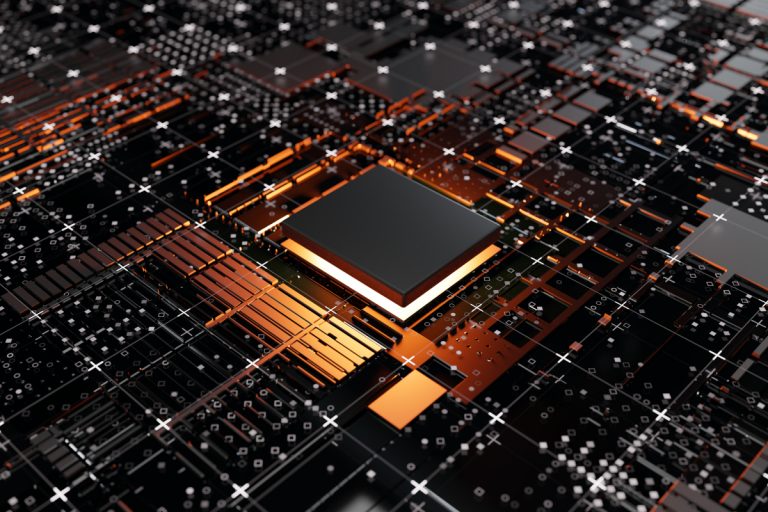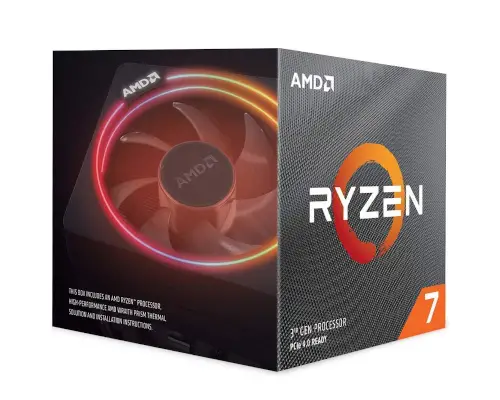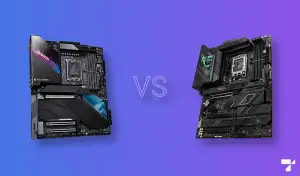AMD CPUs provide excellent performance and value when it comes to multitasking and productivity, but they also provide excellent processors for gaming. Therefore, we have curated a list of the best AMD CPUs for gaming.
If you want to build or update your gaming PC to an AMD CPU, below we have included a wide variety of AMD processors for all budgets. We’ll take a look at both budget options and a couple of higher-end models for people with higher budgets so that you can select the ideal CPU for your PC.
1. AMD Ryzen 7 3700X
Architecture: Zen 2 | Socket: AM4 | Cores/Threads: 8/16 | Base/Boost Frequency: 3.6GHz/4.4GHz | TDP: 65W | Process: 7nm
While there might be one or two options that provide a better value, the Ryzen 7 3700X is currently one of the best AMD chips for gaming in terms of raw performance. It makes use of AMD’s Zen 2 architecture and uses the AM4 socket, which gives you wide compatibility with plenty of motherboard options.
It comes with eight cores and sixteen threads, which is quite a bit better than the quad-core models that you’ll come across and allows for much better performance in multithreaded applications. Not only will you be able to game on it with ease, but it’s also good if you want to stream your gameplay, too.
The base frequency is a pretty generous 3.6GHz, but that’s not the highest. If you push it in intensive scenarios, the 3700X can boost all the way up to 4.4GHz, which is pretty good.
Alongside it, you get a Wraith Prism cooler, an air cooler that’s got RGB lights, and does a surprisingly good job at keeping the 3700X cool.
Features:
- Excellent eight-core configuration for heavy workloads
- High boost frequency of 4.4GHz
- AM4 socket with great motherboard compatibility
- An included cooler that does a great job and has RGB lights
2. AMD Ryzen 5 3600
Architecture: Zen 2 | Socket: AM4 | Cores/Threads: 6/12 | Base/Boost Frequency: 3.6GHz/4.2GHz | TDP: 65W | Process: 7nm
If you’re after the most bang-for-your-buck processor, one that will provide excellent value while giving you stellar performance in terms of gaming, the Ryzen 5 3600 is probably where you want to end up. It’s one of the best AMD CPUs for gaming, and it currently comes at a very wallet-friendly price.
This is a six-core, twelve thread processor, which means that not only will you get excellent performance in gaming, but you’ll be more than set for heavier tasks that demand more cores and power, such as streaming, for example. With a base frequency of 3.6GHz and a maximum boost of up to 4.2GHz, it can go pretty high in this regard, too, which is great.
You have support for DDR4 memory at 3200MHz, and you’ll be getting the AMD Wraith Stealth cooler in the box. The cooler doesn’t have any fancy features, but it keeps the CPU cool pretty well. Considering this is only a 65W TDP CPU unless you push it really hard, you won’t even need to go aftermarket with your cooler.
Features:
- Phenomenal bang-for-the-buck
- Six core configuration that’s great for gaming
- An excellent base clock at 3.6GHz
- An included cooler that’s rather quiet
3. AMD Ryzen 3 3300X
Architecture: Zen 2 | Socket: AM4 | Cores/Threads: 4/8 | Base/Boost Frequency: 3.8GHz/4.3GHz | TDP: 65W | Process: 7nm
When they initially released the 3000 series CPUs, AMD focused on the midrange and high-end models. Not too long ago, they released somewhat of a refresh, and one of the new CPUs was the new Ryzen 3 3300X. At a very reasonable price, it competes (and puts to shame) most of today’s budget processors on the market.
While this is a four-core, eight-thread CPU, it’s still a tremendous pick if you’re on a budget. You get a pretty high base frequency of 3.8GHz, but if you push it, it can turbo up to 4.3GHz, which is higher than even some higher-end CPUs.
To add to this, you’re looking at an AM4 socket, so you have plenty of compatibility with new motherboards, and it even works with the new PCIe 4.0 standard so you can get some really great speeds out of a compatible SSD.
In the box, you’ll also get the Wraith Stealth cooler, which is pretty good for the 3300X, as it has a TDP of only 65W and can remain cool under load.
Features:
- A great option for people on a tight budget
- Four core, eight-thread configuration
- A high base clock of 3.8GHz
- Compatibility with PCIe 4.0
4. AMD Ryzen 9 3950X
Architecture: Zen 2 | Socket: AM4 | Cores/Threads: 16/32 | Base/Boost Frequency: 3.5GHz/4.7GHz | TDP: 105W | Process: 7nm
If you were to take the Threadripper models from AMD, the Ryzen 9 3950X is currently the most powerful desktop processor they offer, and there are plenty of reasons for that. While expensive, the CPU is still pretty great in terms of value, and you’re getting a lot for your money.
To begin with, this is a 16 core, 32 thread CPU. This makes it great not for just gaming, but also for heavily multithreaded scenarios such as streaming, or rendering, or video editing, all of which can be taxing on a CPU. It just glides through any heavy workload with incredible ease.
The base frequency is 3.5GHz, which is decent but push the 3950X, and it will easily boost up to 4.7GHz, which is impressive. Note that it also has a TDP of 105W, and AMD doesn’t include a cooler with it, so you’ll want some way of keeping it cool – liquid is preferred.
All things considered, if money is not a problem, the AMD Ryzen 9 3950X is definitely one of the best AMD CPUs for gaming.
Features:
- 16 cores are excellent for highly demanding scenarios
- Very high boost frequency of 4.7GHz
- AM4 socket offers great compatibility with motherboards
- Even though expensive, still a decent value
5. AMD Ryzen 5 3600X
Architecture: Zen 2 | Socket: AM4 | Cores/Threads: 6/12 | Base/Boost Frequency: 3.8GHz/4.4GHz | TDP: 65W | Process: 7nm
While many argue that a Ryzen 5 3600 is more than enough, if you simply need slightly higher clock speeds that will give you a bit of a performance boost, the Ryzen 5 3600X is right up your alley. It comes with an excellent core count and great frequencies, which makes it perfect for both gaming and heavier, more CPU-intensive workloads.
This six-core, twelve thread CPU runs at a base frequency of 3.8GHz, but when pushed under load, you can expect it to boost up to 4.4GHz. You’ll notice that both frequencies are slightly higher than the non-X variant, which will result in slightly better performance. This is something you’ll certainly notice when pushing the CPU hard.
In the box, you will also find an AMD Wraith Stealth cooler. While it has no RGB lights, it is a cooler that’s perfectly capable of keeping this 65W TDP processor within reasonable temperatures, even when you push it harder. All things considered, this is an excellent value proposition, and certainly one of the best AMD CPUs for gaming.
Features:
- A great value proposition for many users
- Six cores are more than enough for demanding games
- High frequencies with a 3.8GHz base and 4.4GHz boost frequency
- Included Wraith Stealth cooler
6. AMD Ryzen 9 3900X
Architecture: Zen 2 | Socket: AM4 | Cores/Threads: 12/24 | Base/Boost Frequency: 3.8GHz/4.6GHz | TDP: 105W | Process: 7nm
Sure, the 3950X is a more powerful option, but those of you who don’t need sixteen cores will find that the AMD Ryzen 9 3900X is an excellent CPU for gaming. It’s part of AMD’s high-end Ryzen 9 series of CPUs, and for gaming, it’s an excellent option.
You’re looking at “only” twelve cores, and twenty-four threads, which means that you’ll be able to easily push the CPU rather hard in a variety of scenarios, such as gaming, video editing, or 3D rendering. It’s going to perform admirably no matter the task, which is why it’s one of the best AMD CPUs for gaming and working.
Inside the box, you will also get AMD’s Wraith Prism cooler. While some might prefer going aftermarket and opting for liquid cooling instead, the Wraith Prism does a really good job with the temperatures, even though this is a 105W TDP processor that should get pretty hot. This is definitely an excellent choice for people who don’t mind spending a bit more for excellent performance in games.
Features:
- High core count is great for intensive workloads and demanding scenarios
- Excellent base frequency at 3.8GHz
- Included Wraith Prism cooler with RGB and great performance
- Great value for the performance you’re getting
7. AMD Ryzen 7 3800X
Architecture: Zen 2 | Socket: AM4 | Cores/Threads: 8/16 | Base/Boost Frequency: 3.9GHz/4.5GHz | TDP: 105W | Process: 7nm
Somewhere between the midrange Ryzen 5 and the high-end Ryzen 9 processors are the Ryzen 7 series – and the Ryzen 7 3800X is the most powerful of that lineup. It’s got a lot going for it, including a rather decent core count and frequencies that can handle intensive gaming without even blinking.
We’re talking about 8 cores and 16 threads, which is considered to be pretty much the minimum if you’re not on a budget. They make sure the 3800X glides with ease through just about any workload you can think of, and that includes gaming and streaming, too. The base frequency is 3.9GHz, but push it harder, and it will easily boost up to 4.5GHz, which is rather nice.
To keep it cool, AMD has included its excellent Wraith Prism cooler, which also has a bit of RGB lighting to add to your case. It’s a great cooler, but with a 105W TDP, you might want to go aftermarket if you’re going to push it hard.
Features:
- Good balance between price and performance
- High base frequency at 3.9GHz
- 8 cores and 16 threads are great for both gaming and streaming
- An included cooler that does a great job at keeping temperatures low
8. AMD Ryzen 3 3100
Architecture: Zen 2 | Socket: AM4 | Cores/Threads: 4/8 | Base/Boost Frequency: 3.6GHz/3.9GHz | TDP: 65W | Process: 7nm
AMD is pretty much dominating the entry-level CPU market, but that doesn’t stop them from releasing new, updated processors that are even better in that regard. A perfect example is the Ryzen 3 3100, a CPU that was just released, costs very little, and performs rather well in budget builds when it comes to gaming.
This little quad-core, eight-thread CPU will perform rather nice in games thanks to its pretty high base frequency of 3.6GHz. Unfortunately, with a maximum boost of up to 3.9GHz, you won’t be pushing it too hard, but this is still pretty great and you won’t notice any issues. One thing to note is that it doesn’t come with an integrated graphics card, so you’ll need a dedicated model to get it up and running.
Inside the box, you also get a cooler, and it’s AMD’s well-proven Wraith Stealth, that does more than a great job at keeping this 65W TDP processor at bay in terms of temperatures. Overall, Ryzen 3 3100 is an excellent CPU for users on a budget.
Features:
- Wallet-friendly price
- Four cores are great for a budget gaming
- An included cooler that’s more than capable of keeping temperatures low
9. AMD Ryzen 7 2700
Architecture: Zen+ | Socket: AM4 | Cores/Threads: 8/16 | Base/Boost Frequency: 3.2GHz/4.1GHz | TDP: 65W | Process: 12nm
While certainly not the newest AMD CPU out there, the Ryzen 7 2700 still holds its own as one of the best AMD CPUs for gaming. It has all the cores you need, decent frequencies, and it’s easy enough to keep cool even under load.
To begin with, the configuration of this Zen+ chip is eight cores and sixteen threads. Not only is this excellent for gaming, but it can also easily handle more intense workloads, such as streaming or video rendering. The base frequency is a pretty reasonable 3.2GHz, but push it, and it will boost up to 4.1GHz without any issues.
Inside the box, you’ll get an AMD Wraith Spire cooler, which is the previous iteration of what AMD offers now. However, at a 65W TDP, this CPU isn’t too difficult to cool, so the air cooler does a great job at keeping temperatures at bay.
If you don’t need the latest model and would like to get a higher core count with your CPU, the Ryzen 7 2700 is an excellent pick.
Features:
- Older architecture results in better bang-for-your-buck
- High core count makes it great for both gaming and streaming
- Boost frequency of up to 4.1GHz
- 65W TDP means it’s rather easy to keep cool
10. AMD Ryzen 5 2600
Architecture: Zen+ | Socket: AM4 | Cores/Threads: 6/12 | Base/Boost Frequency: 3.4GHz/3.9GHz | TDP: 65W | Process: 12nm
While many consider its successor to be the best bang-for-the-buck CPU at the moment, the Ryzen 5 2600 is a great way to get plenty of cores, decent frequencies, and an easy-to-cool processor, all while saving a bit of money by going for a Zen+ architecture instead of the new Zen 2.
You get six cores and twelve threads, which is more than enough for gaming, and a base frequency of 3.4GHz that can go up to 3.9GHz. This is a pretty nice combination, and you’ll get very respectable framerates in games, especially if paired with a good GPU. You could even try streaming with it, and video editing shouldn’t be too much of an issue either.
Keeping it cool is the AMD Wraith Stealth cooler that’s near-silent, yet keeps temperatures at bay. This is a 65W CPU, after all, so you might not need to get aftermarket cooling for it unless you’re going to push it hard for extended periods. Overall, it’s a great pick for a variety of scenarios, especially gaming.
Features:
- Excellent value for your money
- Great core and thread configuration for both gaming, and slightly more intensive workloads
- An included cooler that’s quiet and does a great job
What to look for in an AMD gaming CPU
When you’re building a new AMD-based system, there are a couple of things you should be looking for. Let’s take a look at some of the basics, and show you where you should spend your money to get the best AMD CPU for gaming.
Core count
One of the first things you should be looking at is the core count. Even though at one point four core systems were considered high end, today we’ve got options, especially from AMD, that go extremely high in this department.
If you’re on a budget, the bare minimum you should be going for is four cores. This is what you’ll get from a Ryzen 3 CPU, which is known to be good value. However, if you can afford it, you should step up to a Ryzen 5, which tends to come with six cores. Those two extra cores will come in handy, especially if you’d like to push your system with heavier workloads every once in a while, or do things such as streaming while you’re gaming.
However, if you’re willing to spend a bit more money, you can easily go with a higher core CPU. The Ryzen 7 models tend to be eight cores, while with Ryzen 9 you can choose between 12 and 16 cores, depending on the CPU you go for. In any case, with cores it’s simple – higher is better, and you should always get as much as your budget allows.
Frequency
On the list of priorities, the frequency is right after the core count. It’s rather simple here as well – higher frequencies equal better speed. You’ll note two frequencies mentioned with AMD CPUs, one of which is the base, while the other is a boost. The base frequency is the minimum frequency you’ll notice your CPU running at. However, if it notices a more intensive workload, such as a more demanding game, it’s designed to increase the frequency. The maximum is the aforementioned boost frequency, and that’s usually as high as a CPU will go.
Now, you could try overclocking your CPU to get higher frequencies. However, with AMD CPUs, especially the third generation Ryzen, overclocking has shown to have adverse effects on the durability and long term performance of your processor, so it’s not something we would recommend. Instead, avoid it if you can.
Which is more important?
With core count and frequency, you’ll notice that many AMD CPUs tend to have one better than the other. For example, you’ll find some with plenty of cores, but a lower frequency, and you’ll find low core counts with higher frequency, which begs the question – which one is more important?
This is an individual thing, because both things impact your day-to-day experience in different ways, and you should see the specific scenarios you’ll find yourself in. For example, a few years ago games seldom used more than a single core of your CPU, and higher frequencies were usually better. However, today they’re made to utilize multiple cores, which is why a quad-core CPU isn’t high end anymore.
Here, when you’re on a limited budget, it’s a matter of compromise and deciding which one you need more. If the apps and games you’re going to be running on your system make use of multiple cores, you could sacrifice a bit in terms of frequency to get two, or four, more cores, as this will have a larger benefit for you. On the other hand, if your specific workloads don’t really demand more cores, you could easily get away with a lower core count, but a higher base and boost frequencies.
Integrated GPU
Another thing to keep in mind, especially with budget builds, is whether or not your CPU has an integrated graphics card. With midrange or high-end gaming rigs, this isn’t too much of a concern since chances are you already have a dedicated GPU and the integrated one doesn’t make much of a difference.
However, if you’re on a budget and you’re looking to save every dollar possible, you might want to resort to an integrated GPU for the time being. In this scenario, with a processor that doesn’t have an integrated graphics card, you’ll get no video output.
For example, the Ryzen 3 3300X and the Ryzen 3 3100 don’t have integrated GPUs, so you’ll need some kind of graphics card to keep your system running. This is also the case with the higher-end Ryzen 7 and Ryzen 9 processors, so make sure you have your budget set for that.
Cooling solution
The last thing you should be looking for with your AMD CPU is the cooling solution. Most of today’s AMD CPUs are either rated at a 65W or a 105W TDP, which isn’t too difficult to keep cool. AMD is well aware of this, which is why they include some kind of cooler with most of their CPUs, save for the highest end, 3950X model.
The coolers included range from the Wraith Stealth, which is a pretty modest, and rather quiet cooler, to the Wraith Prism. While the Wraith Stealth is pretty good for cooling 65W CPUs that don’t get too hot, for something like a Ryzen 7, we’re glad AMD includes the Wraith Prism. Even if you were to ignore the aesthetic improvements (most notably, the RGB), the Prism is a much beefier cooling solution with a larger fan and better build.
But, one thing must be said. Even though AMD is doing a great job at pairing their CPUs with a cooler that does a great job with them, nothing will keep the temperatures at bay like a good aftermarket cooler. Whether it’s a budget air cooler like a Cooler Master Hyper 212, or a high-end AiO like an NZXT Kraken, these solutions will shave off a few more degrees from your CPU temperature. If you’re not that limited with your budget, by all means, include an aftermarket cooler in your build.
Wrapping things up
At the end of the day, you’ll notice that AMD has a pretty good range of options, going from budget processors that have a great value, to some high-end behemoths with very high core counts and clock speeds.
All you have to do is set a reasonable budget for your build, and then choose the CPU above that suits your needs and requirements most. Whichever one you go for, you won’t regret it, as above we’ve got the best AMD CPUs for gaming for pretty much anyone’s wallet.




